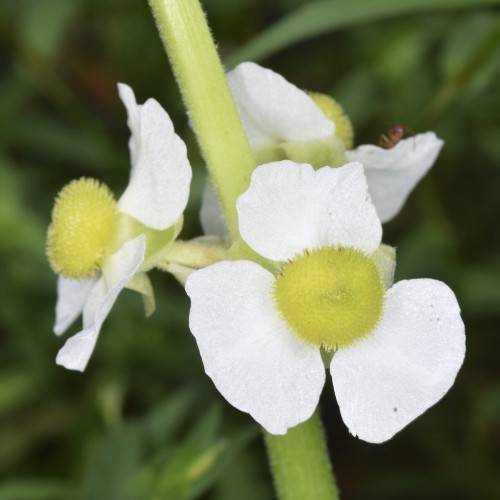
broadleaf arrowhead
Sagittaria latifolia
Also Known As - arrowhead,duck potatoCycle:
Herbaceous Perennial
Watering:
Frequent
Hardiness Zone:
5 - 10
Flowers:
Flowers
Sun:
Full sun
Soil:
Bog
Fruits:
Fruits In Summer Ready In Fall
Edible:
Yes
Leaf:
Yes
Growth Rate:
High
Maintenance:
Moderate
Drought Tolerant:
Yes
Salt Tolerant:
Yes
Thorny:
Yes
Invasive:
Yes
Care Level:
Medium
watering
Broadleaf arrowhead should be watered once a week, at a rate of 1 inch of water per week. The water should be evenly distributed over the entire area the plant is growing in. It is best to water in the morning when evaporation is low. Also, after the first few weeks of watering, a slow flow rate should be used to ensure deep penetration of the roots. A mulch layer should also be added to the soil to help with water retention and help reduce the need for frequent watering.
sunlight
Broadleaf arrowhead (Sagittaria latifolia) does best with 4 to 5 hours of direct sunlight each day when planted outdoors. This sunlight should be evenly spread throughout the day, with several hours of direct sunlight in the morning, and several hours in the late afternoon or early evening. If planted indoors, this plant should be placed near a window that will get plenty of bright indirect sunlight or it should be supplemented with artificial light. If artificial light is used, it should be full spectrum, cool white fluorescent lighting for best results.
pruning
Broadleaf arrowhead (Sagittaria latifolia) can be pruned in late spring (May or June) and then again in fall (September or October). This plant is best pruned when flowering is done; if flowering is not a concern, it can be pruned whenever new growth dominates. During the first growth of the season, pruning should be done to promote bushier foliage growth. This pruning should include cutting off any unproductive stems and back-cutting long stems that have outgrown their balance with the rest of the plant. In the late fall, give the plant a final pruning to promote bushiness throughout the winter and increase the chance of surviving cold temperatures. Before the first hard freeze of the year, remove all dead or dying leaves and stems so the plant can absorb energy more efficiently. Cut back any out of proportion stems to create a better balanced plant. Once the growing season begins, you can prune for shaping, but do not prune more than 1/4 of the leaf or stem in a single season and do not remove more than 1/3 of the leaves or stems overall. If your plant has become spindly, you may need to prune it drastically, as much as half of its growth. Once the broadleaf arrowhead plant is established, pruning should rarely be necessary, as it does not usually require much maintenance.
